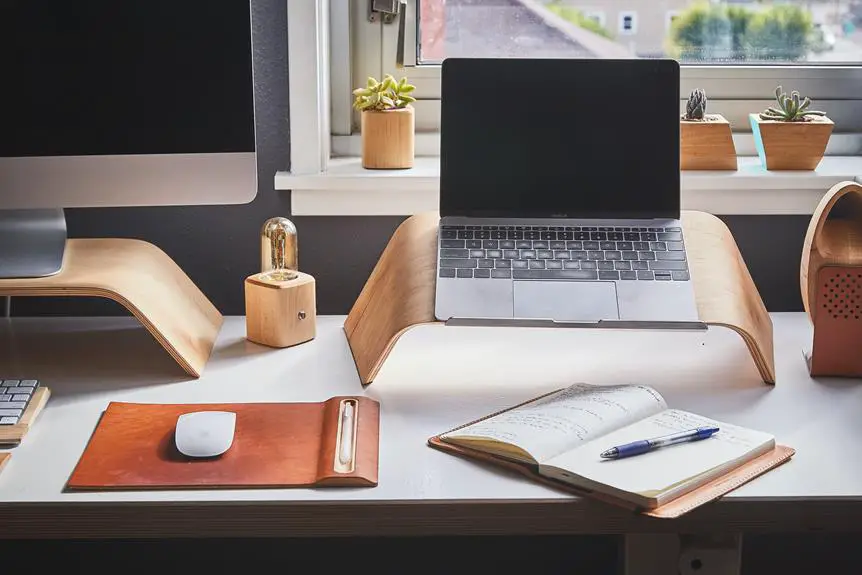Looking to harness the power of multiple screens for peak home office productivity? Discover the optimal multi-monitor setup for your workspace.
Maximize your efficiency and streamline your workflow with the right combination of monitors and configurations. Uncover the key factors to consider, from display types to ergonomic placement.
Enhance your mastery of multi-monitor productivity with the latest software and tools. Get ready to revolutionize your home office setup and unleash your full potential.
Key Takeaways
- Better workspace organization
- Enhanced productivity and multitasking
- Time-saving and reduced task-switching
- Improved time management
Benefits of Multi-Monitor Setups
For home office productivity, using multiple monitors can significantly boost your efficiency and task management. The benefits of a multi-monitor setup are numerous.
Firstly, it allows for better workspace organization. With multiple screens, you can dedicate each one to a specific task or application, reducing clutter and streamlining your workflow. This not only saves time but also creates a more organized and visually appealing work environment, which can positively impact your overall productivity.
Another advantage is the productivity benefits it offers. Having multiple monitors enables you to multitask more effectively. You can have research materials open on one screen while writing on another, or keep your email and calendar visible at all times. This can lead to improved time management and a reduction in task-switching time, ultimately enhancing your productivity.
However, it's important to consider potential issues such as eye strain and monitor positioning. Ensure that the monitors are positioned at eye level and at an appropriate distance to minimize strain. Additionally, taking regular breaks and adjusting screen brightness can help mitigate any potential discomfort.
Types of Multi-Monitor Configurations
To optimize your home office productivity, consider configuring your multi-monitor setup in one of three common arrangements. Each arrangement offers unique benefits and considerations, so it's important to choose the one that best suits your needs. Here are some key factors to consider when deciding on the type of multi-monitor configuration for your home office:
- Mounting Options: When setting up your multi-monitor display, consider whether to use stands or wall mounts. Stands provide flexibility and easy adjustment, while wall mounts can help save desk space and create a streamlined look.
- Screen Type: Another important consideration is whether to use curved or flat screens. Curved screens offer a more immersive viewing experience and can reduce eye strain, while flat screens are often more affordable and easier to integrate into existing setups.
- Alignment: Decide whether you want your monitors to be aligned in a straight line or if you prefer a more angled or curved arrangement.
- Size and Resolution: Consider the size and resolution of each monitor to ensure they complement each other and provide a seamless viewing experience.
- Cable Management: Lastly, think about how you'll manage the cables for your multi-monitor setup to maintain a tidy and organized workspace.
Factors to Consider When Choosing Monitors
When choosing monitors for your home office setup, consider the screen size and resolution to ensure comfortable viewing and crisp image quality.
Additionally, check for connectivity and compatibility with your devices to make sure everything works seamlessly together.
These factors play a crucial role in creating an efficient and productive multi-monitor setup for your work environment.
Screen Size and Resolution
When selecting monitors for a multi-monitor setup in your home office, it's essential to consider the screen size and resolution to optimize your productivity. Here are some key factors to consider:
- Display Size Comparison: Compare the physical size of various monitors to understand how much screen real estate you need.
- Pixel Density: Higher pixel density results in sharper images and text, enhancing the overall viewing experience.
- Aspect Ratio Options: Consider whether a standard 16:9 aspect ratio or an ultrawide 21:9 ratio would better suit your multitasking needs.
- Refresh Rate Requirements: For tasks involving motion graphics or gaming, a higher refresh rate monitor can provide smoother visuals.
- Resolution: Choose a resolution that balances sharpness and performance, such as 1440p or 4K, based on your specific work requirements.
Considering these factors will help you create an efficient and comfortable multi-monitor setup for your home office.
Connectivity and Compatibility
Consider the number of video outputs your computer has available, as this will determine how many monitors you can connect to your setup.
Ensure your monitors are compatible with your computer's video outputs, and that the necessary cables are available for connection.
When choosing monitors, look for ones that offer software integration for seamless multi-monitor use. This will allow you to easily manage and customize your display across multiple screens.
Additionally, consider cable management to keep your workspace organized and free from clutter. Look for monitors that support cable management features to keep cables neatly organized and out of the way.
Ergonomics and Multi-Monitor Productivity
To maximize your home office productivity with a multi-monitor setup, it's essential to position the screens at eye level to reduce strain on your neck and shoulders. An ergonomic setup offers numerous productivity benefits, allowing you to work comfortably for extended periods.
Here are some key tips for optimizing your multi-monitor workstation:
- Adjust Monitor Height: Use adjustable monitor stands or VESA mounts to ensure that the top of each screen is at or slightly below eye level.
- Minimize Glare: Position the monitors to avoid glare from windows or overhead lighting, which can cause eye strain and reduce visibility.
- Maintain Proper Distance: Sit at an arm's length distance from the monitors to prevent eye fatigue and maintain a comfortable viewing angle.
- Organize Cables: Keep cables tidy and out of the way to create a clean and clutter-free workspace, reducing distractions and improving focus.
- Invest in Ergonomic Accessories: Consider ergonomic keyboards, mice, and chairs to complement your multi-monitor setup and promote overall comfort and efficiency.
Software and Tools for Multi-Monitor Efficiency
To enhance the efficiency of your multi-monitor workstation, integrate software and tools that facilitate seamless multitasking and screen management. Monitor arrangement and display management are crucial for maximizing productivity.
Utilize productivity tools such as DisplayFusion, which allows for easy management of multiple monitors by providing features like multi-monitor taskbars, customizable hotkeys, and window management. This tool simplifies workspace organization by enabling you to create personalized monitor profiles and split large monitors into smaller virtual ones.
Additionally, leveraging Microsoft's PowerToys can enhance your workflow with features such as FancyZones, enabling custom window layouts and quick window positioning.
For Mac users, Magnet is a valuable tool for organizing windows across multiple monitors, making it effortless to snap windows into pre-defined areas.
These software and tools are essential for optimizing your multi-monitor setup, ensuring that you can efficiently navigate through various tasks and applications. By incorporating these tools into your workstation, you can streamline your workflow and boost overall productivity.
Tips for Setting Up a Multi-Monitor Workspace
When setting up your multi-monitor workspace, consider the ergonomics of monitor placement to reduce strain on your neck and eyes.
Implement cable management solutions to keep your workspace tidy and free of clutter.
Additionally, explore software options for efficient screen management to maximize your productivity.
Monitor Placement Ergonomics
Position your monitors at eye level to reduce neck strain and improve overall ergonomics in your multi-monitor workspace. Proper monitor positioning is crucial for maximizing productivity and minimizing discomfort. Here are five essential tips for setting up your multi-monitor workspace:
- Maintain a Straight Neck: Adjust your monitors so that the top of the screen is at or slightly below eye level to keep your neck in a neutral position.
- Minimize Glare: Position the monitors perpendicular to windows and use shades or curtains to reduce glare and reflection on the screens.
- Ensure Equal Distance: Keep an equal distance between all monitors to prevent uneven strain on your eyes and neck.
- Use Monitor Arms: Consider using adjustable monitor arms to easily position and customize the arrangement of your monitors.
- Consider Ergonomic Accessories: Invest in ergonomic accessories such as monitor stands or risers to achieve the optimal monitor placement for your unique setup.
Cable Management Solutions
First, ensure that your cables are organized and neatly secured to prevent clutter and maintain a clean workspace in your multi-monitor setup. Effective cable management not only enhances the aesthetics of your workspace but also contributes to productivity improvement by reducing distractions and streamlining your workflow. Here are some cable management solutions to consider:
| Cable Management Solutions | Description |
|---|---|
| Cable Sleeves | Conceals and bundles multiple cables, keeping them neat and tangle-free. |
| Cable Clips | Secure cables to the edge of your desk or along the monitor stand, preventing them from dangling and tangling. |
| Cable Trays | Mount underneath the desk to store power strips and excess cables, keeping them out of sight and organized. |
Implementing these cable management solutions will not only tidy up your workspace but also contribute to a more efficient and productive home office environment.
Software for Screen Management
To optimize your multi-monitor setup for home office productivity, consider utilizing software for screen management to enhance your workflow and efficiency. Effective screen organization and task allocation are essential for maximizing the potential of your multi-monitor workspace.
Here are some software options to help you achieve seamless screen management:
- DisplayFusion: This software allows you to customize monitor configurations and manage windows with ease.
- Ultramon: It offers features for organizing windows across multiple monitors and provides taskbar extensions for each monitor.
- MultiMonitorTool: This tool enables you to disable/enable monitors, set the primary monitor, and save the configuration for quick setup.
- Actual Multiple Monitors: It provides various tools for improving the usability of multiple monitors, such as multi-monitor taskbars and virtual desktops.
- Windows 10 Virtual Desktops: Take advantage of the built-in virtual desktop feature in Windows 10 to organize tasks across different virtual desktops for efficient multitasking.
Case Studies: Successful Multi-Monitor Users
One of the most effective ways to understand the benefits of a multi-monitor setup is by examining how successful users have integrated it into their home office productivity. By studying the strategies of accomplished remote workers, you can gain valuable insights into how to optimize your own multi-monitor setup for maximum productivity. Here are some case studies of successful multi-monitor users who have implemented productivity hacks to excel in their remote work:
| User | Industry | Productivity Hack |
|---|---|---|
| Sarah Johnson | Graphic Design | Dedicated design software on one screen, reference materials on the other |
| Alex Chen | Financial Analysis | Spreadsheet and data analysis on one screen, email and communication on the other |
| Maya Patel | Software Development | Code editor and development tools on one screen, testing and debugging on the other |
Studying these case studies can provide you with practical ideas for organizing your own multi-monitor setup to enhance your productivity while working from home. Learning from the experiences of successful multi-monitor users can help you implement effective strategies and achieve mastery in your home office productivity.
Frequently Asked Questions
Can Multi-Monitor Setups Improve Work-Life Balance for Remote Workers?
Multi-monitor setups can improve work-life balance for remote workers by offering ergonomic benefits and enhancing remote collaboration. With a larger screen real estate, you can be more efficient and organized, leading to a better work-life balance.
What Are the Best Practices for Managing Cables and Power Cords in a Multi-Monitor Setup?
To manage cables and power cords in a multi-monitor setup, use cable management tools and organization techniques. Ensure power cord safety by using hiding solutions like cable raceways and cord organizers. Keep your workspace tidy and hazard-free.
How Can I Prevent Eye Strain and Fatigue When Using Multiple Monitors for Long Hours?
To prevent glare and eye strain, position your monitors to minimize reflections. Ensure an ergonomic setup with proper monitor height and distance. Adjust brightness and contrast for comfort. Take regular breaks to reduce fatigue and maintain productivity.
Are There Any Specific Multi-Monitor Setups That Are Better for Creative Professionals, Such as Graphic Designers or Video Editors?
For graphic design and video editing, a multi-monitor setup enhances productivity by providing more screen real estate for multitasking. Consider ergonomic considerations to prevent strain. Experiment with various setups to find the best fit for your workflow.
How Can I Troubleshoot Common Issues With Multi-Monitor Setups, Such as Display Connectivity or Resolution Problems?
To troubleshoot common multi-monitor issues, adjust display settings and check for connection issues. Ensure all cables are securely plugged in and update graphics drivers. Verify resolution adjustments in your system settings and restart your computer if problems persist.





